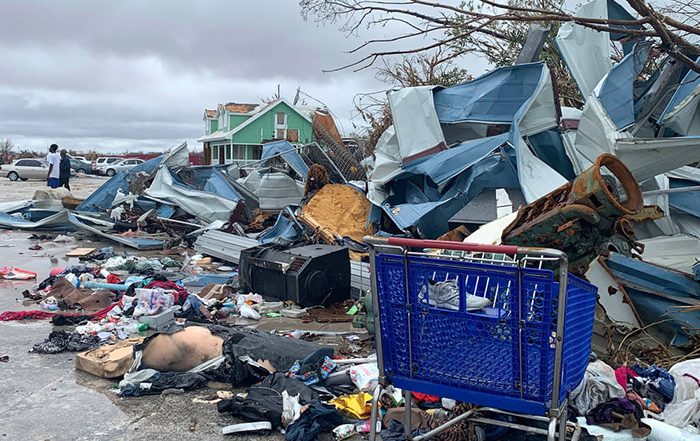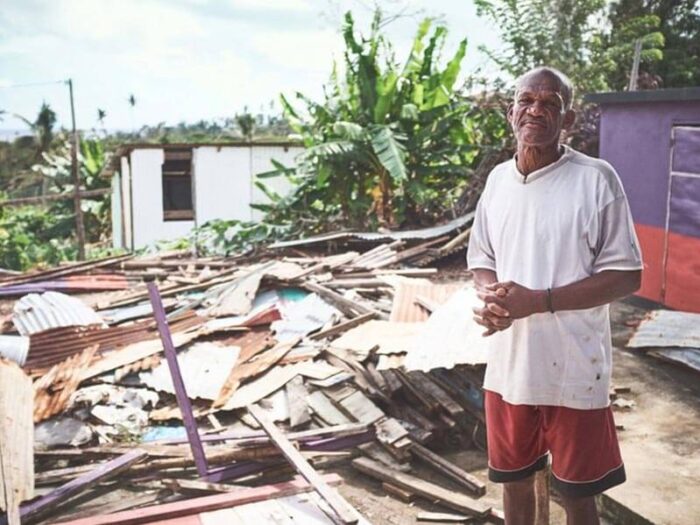We’re responding in the Caribbean after Hurricane Beryl left a trail of devastation across island nations. We’re partnering with Rotary to get emergency shelter aid and other essential items to thousands of people uprooted from their homes in Grenada.
There is widespread destruction across the island nation. Our focus is delivering aid to people on the islands of Carriacou and Petite Martinique (part of Grenada) where most buildings, including homes and schools, have been damaged or destroyed.
Entire communities are living out in the open or in overcrowded buildings like schools. We’ll be providing tents as well as essential items like mosquito nets, solar lights, and cooking sets.
We’ll be using emergency shelter aid that we have stored in Panama for our response. We store aid in Panama and other strategic locations around the world, to make sure we’re ready to respond before a disaster happens.
What aid is ShelterBox providing?
Homes have been destroyed, so our durable, family-sized tents will give people a safe place to start their recovery.
Stagnant water means there is a high risk of disease, in areas where dengue fever is common, so mosquito nets will help families protect themselves.
When there is no power, solar lights can be lifechanging making it possible for families to spend time together in the evenings.
People have been left without any way to cook for their families, so cooking sets will mean people can cook and share a hot meal together. This can bring comfort and a sense of routine during uncertainty.
Hurricanes happen every year. But such a powerful storm so early in the season is very unusual. Scientists predicted that 2024 could be one of the worst years for hurricanes ever. This shows the need to be prepared for these events. We hold aid in warehouses around the world, so we can respond to disasters when we are needed. But we need help to keep those warehouses stocked.
ShelterBox teams are working with other humanitarian organizations in the region and our Rotary network.
Your donation today can help us be prepared to respond to disasters around the world, wherever we are needed.
Being prepared for disasters
Hurricanes and other severe weather events happen every year. These become disasters when people are not prepared, and not supported to recover afterwards.
Some people become trapped in a cycle of disaster, lacking time to recover from one disaster before the next one strikes.
At ShelterBox we aim to be prepared for disasters before they strike. We stock aid materials in warehouses around the world that we can use in an emergency response. Aid material in Panama is ready to be used to respond to Hurricane Beryl if needed.
Watch this video learn more about how we prepare for disasters.
Key facts about Hurricane Beryl
How strong is Hurricane Beryl?
Hurricane Beryl rapidly developed from a tropical depression to a Category 5 hurricane – the strongest level. Winds of 260km/h have been recorded. Winds of this level have the potential to inflict devastating damage to homes and infrastructure.
How many people have been affected?
An estimated 200,000 people – the entire populations of Grenada, Saint Vincent, and the Grenadines, have been affected in some way. However, the most severe shelter needs are in the south of the Grenadines and parts of Grenada.
Currently, it is thought that 70-90% of the buildings on Carriacou and Petit Martinique have been destroyed.


Why is Hurricane Beryl so unusual?
Typically Category 4 or 5 Hurricanes do not develop in the Atlantic this early in the season. Hurricane Beryl is the earliest Category 5 storm ever recorded. Scientists think that the storm developing this early is due to warming sea temperatures, a result of the climate crisis.
It had been predicted that 2024 could be the one of the worst years on records for severe hurricanes. The early appearance of Hurricane Beryl suggests these predictions might be right.
This is very worrying for communities that find themselves in the path of these storms – they might not have the time to recover from one disaster before the next hits.
How we are working with Rotary:
We are partnering with Rotary District 7030 that has an extensive presence across the Caribbean, including Grenada, and St Vincent and the Grenadines. Rotarians have vast experience of responding to disasters following hurricanes. We worked alongside Rotary 7030 after Hurricane Maria hit the Dominican Republic in 2017. We are in direct liaison with Rotary Caribbean Disaster Committee and District and Regional leadership.
“Our partnership with Rotary is again proving to be invaluable, with the Rotary network providing crucial information from their visits to some of the worst affected islands about what people need most. Members of the Rotary in the Caribbean Disaster Committee have been working with us on what our response will look like, so we can make sure we can support communities in their recovery with the right aid items and assistance.” – Alex Youlten, Rotary Partnerships Manager, ShelterBox UK
How does ShelterBox monitor hurricanes?
When we’re monitoring a tropical storm, we use a variety of sources to give us a detailed overview of the situation.
- Windy – this lets us see current weather updates and weather patterns for the next 7/8 days. We can normally identify ahead of time when it looks like a tropical storm / hurricane will start to form, and we can then monitor the storm accordingly.
- GDACS – The Global Disaster Alert and Coordination System is a resource that provides updates on a range of disaster events which rates the overall humanitarian impact of a disaster, and provides updates on the impact of the disaster, as well as resources such as maps of the affected areas.
- Automated Disaster Analysis and Mapping (ADAM) – an interactive map that tracks active tropical storms and earthquakes.
- National Hurricane Centre – a website operated by the National Oceanic and Atmospheric Administration (NOAA) that issues updates and key messaging on tropical storms and hurricanes. They also produce detailed maps and issue advisories for areas where a tropical storm or hurricane is expected to make landfall.
- National Oceanic and Atmospheric Administration (NOAA) – A US government agency, that issues a forecast for the hurricane season.
Depending on where a storm is predicted to make landfall, we will often monitor local news sources and government and disaster management agency websites, to understand how governments and local agencies are preparing for and responding to the storm.
We continue to monitor the situation after the storm has made landfall to understand the impact on affected communities, and to see if there will be an emergency shelter need.
We use our response criteria to make the decision around whether or not we are in a position to respond.


